Sir John Monash, Personal Files Book 10, 18 November - 25 November 1915, Part 1
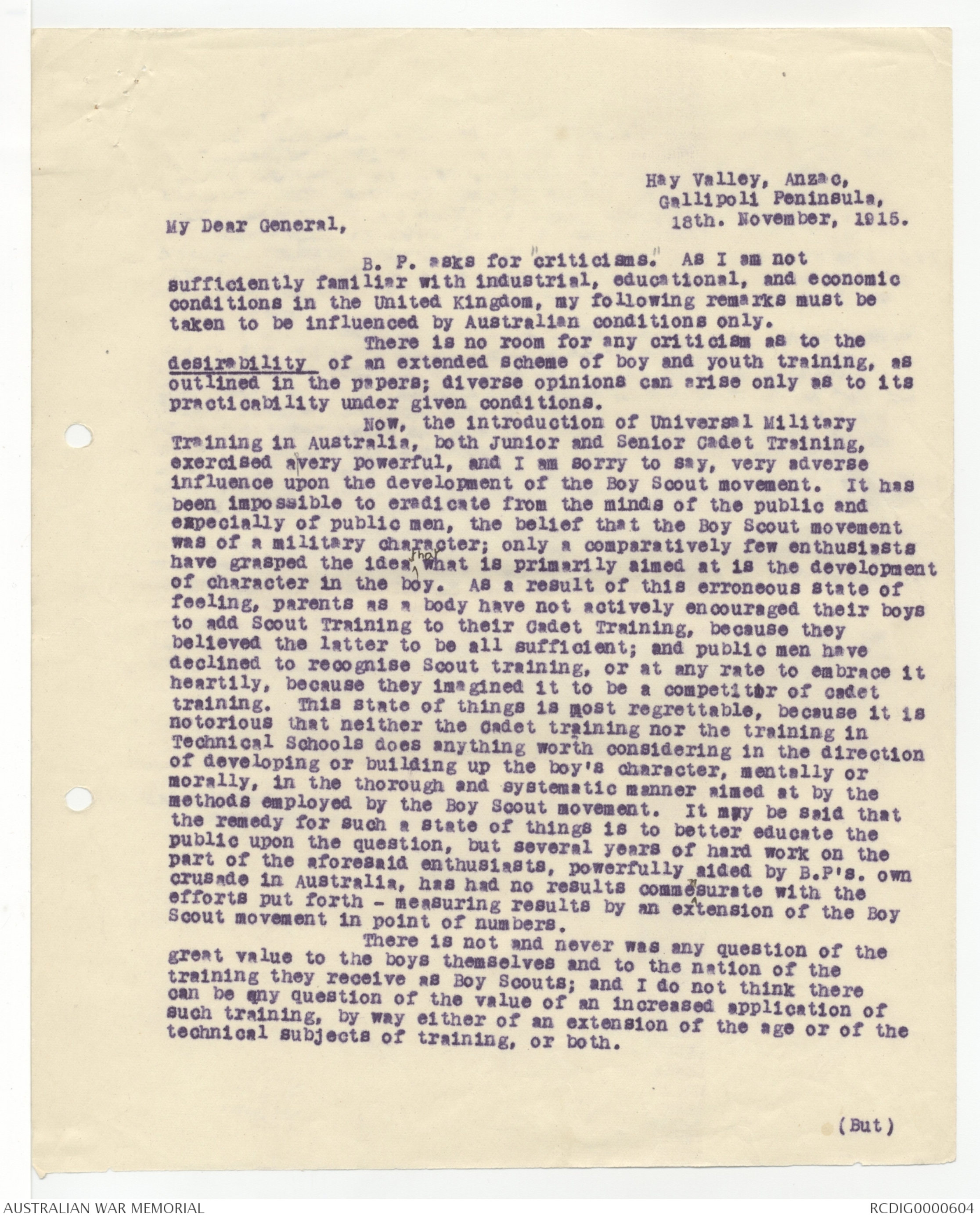
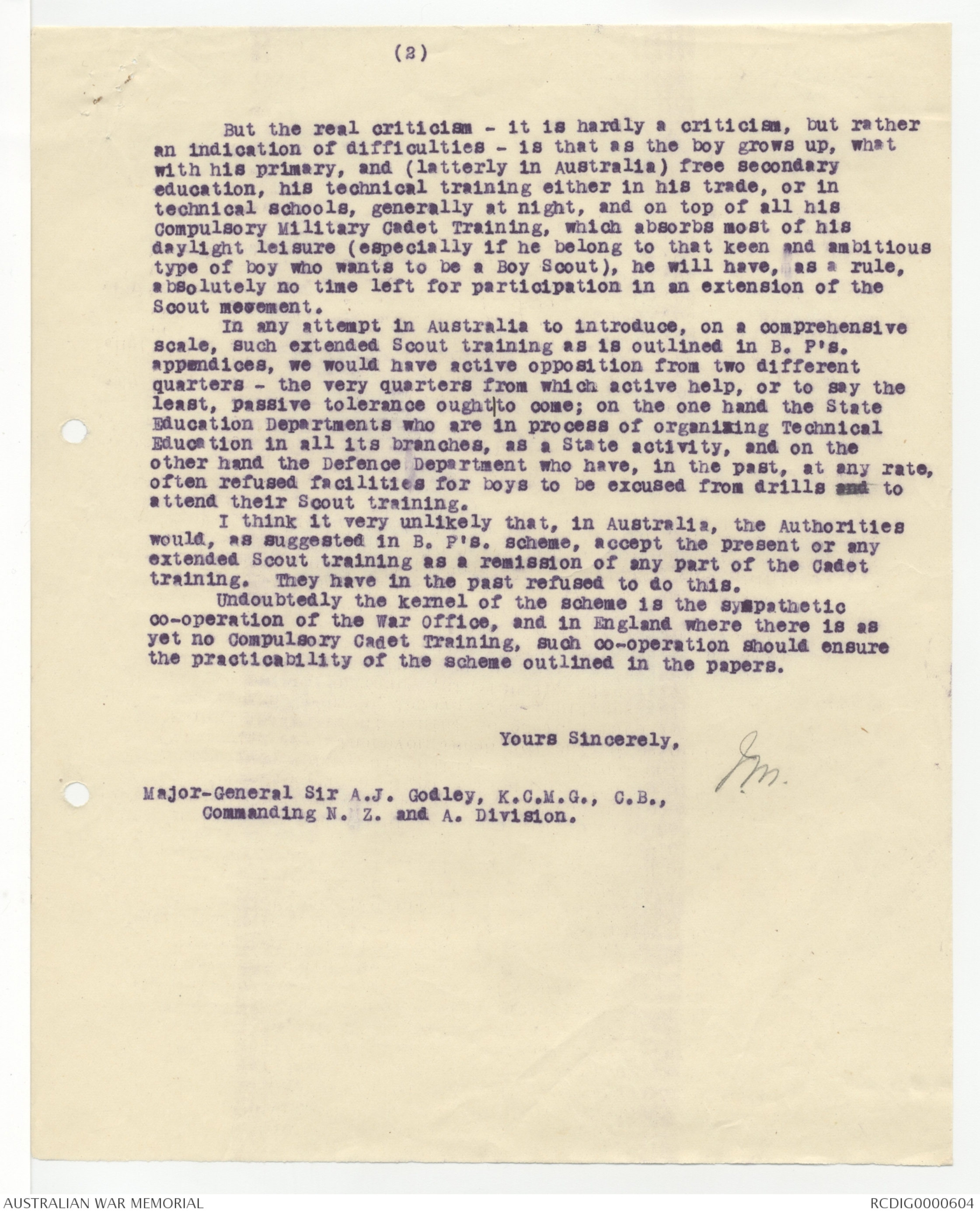
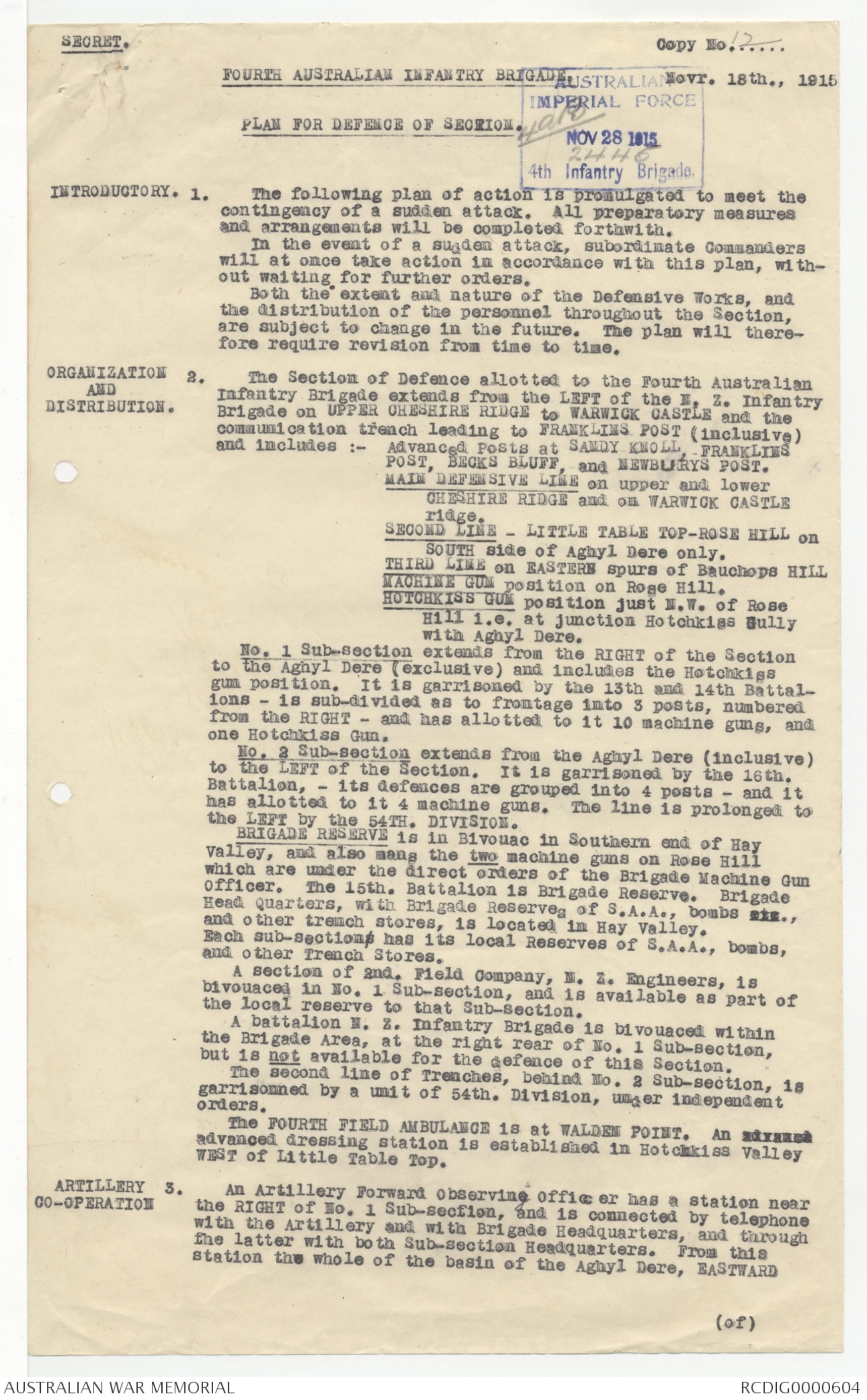
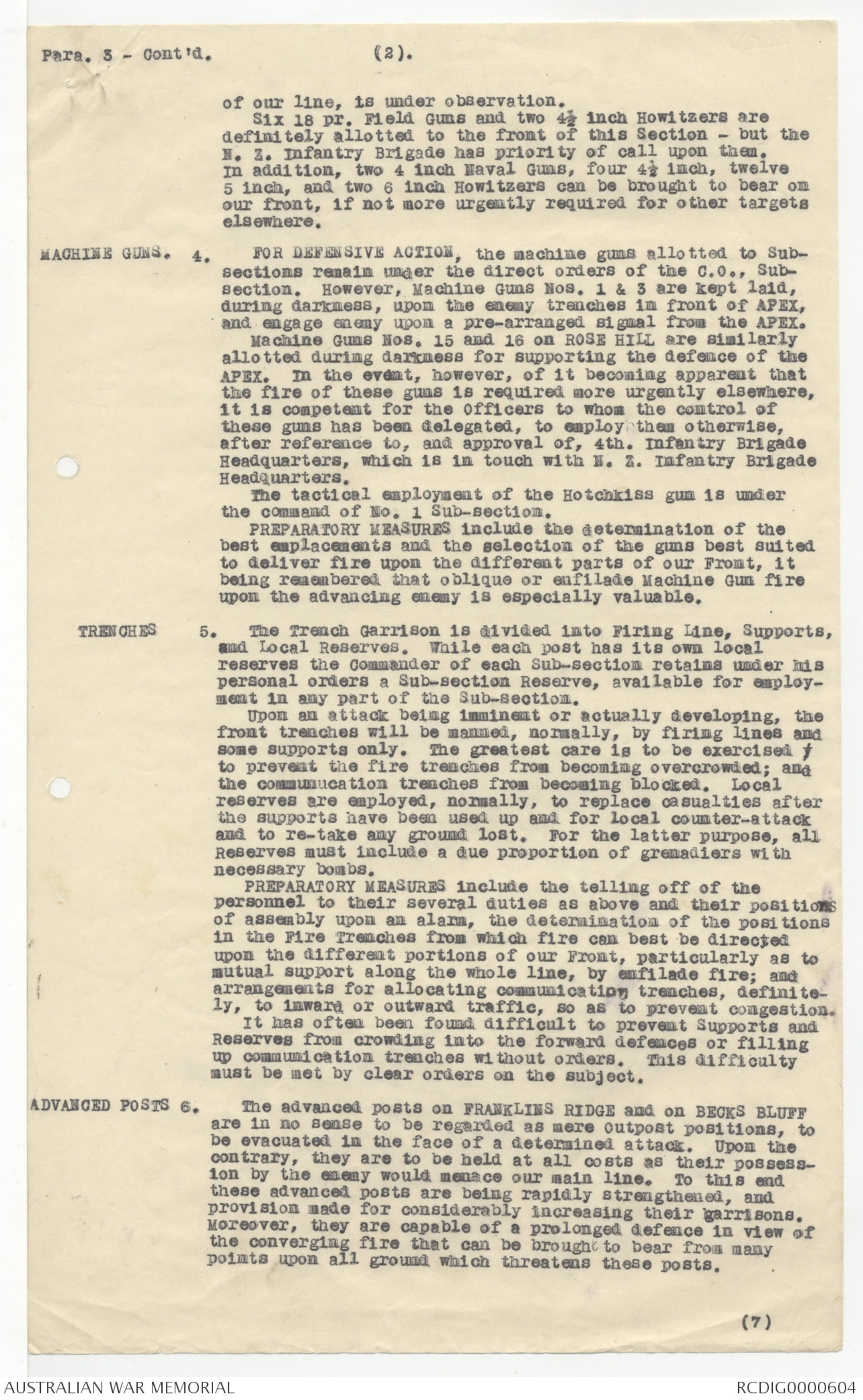
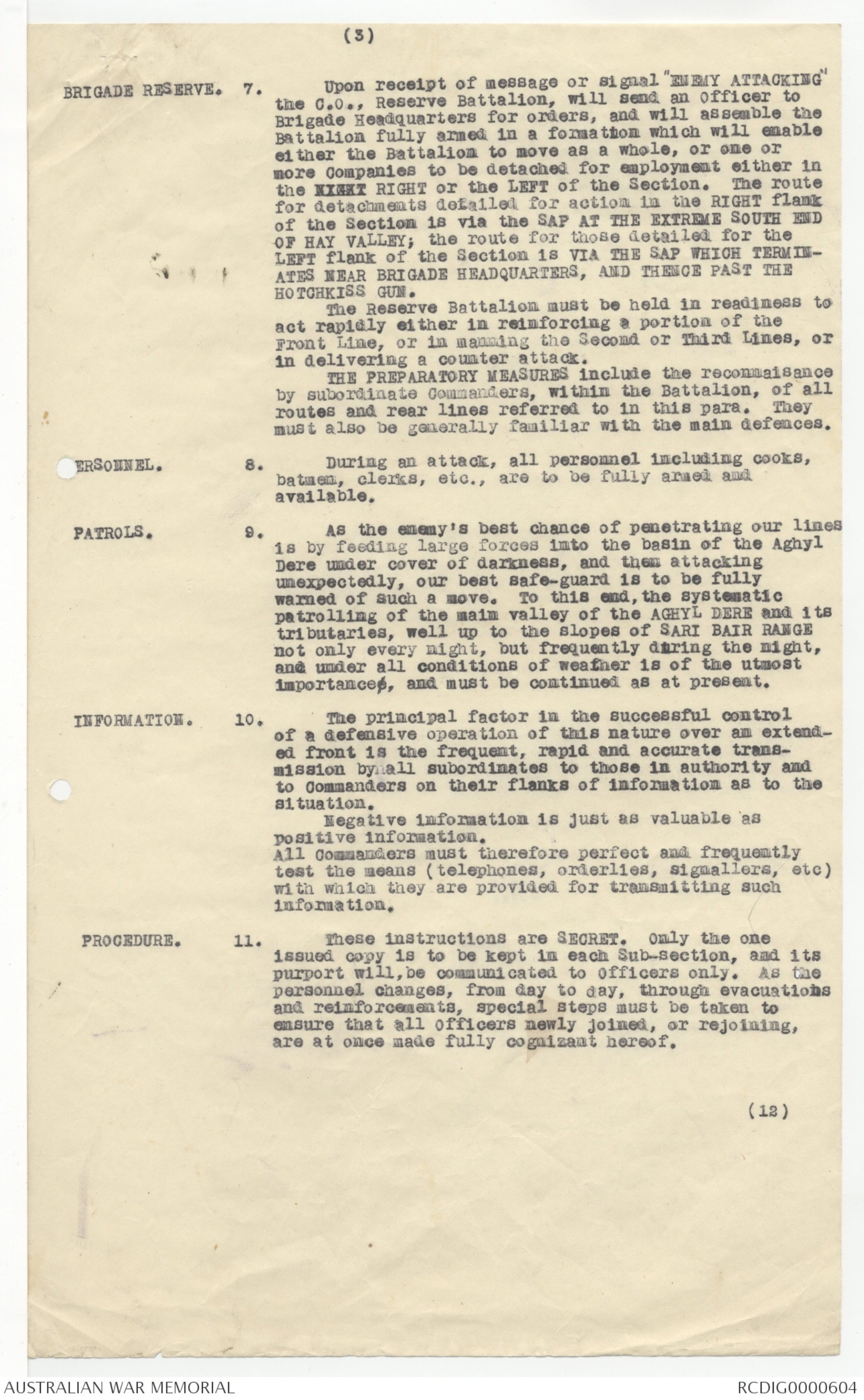
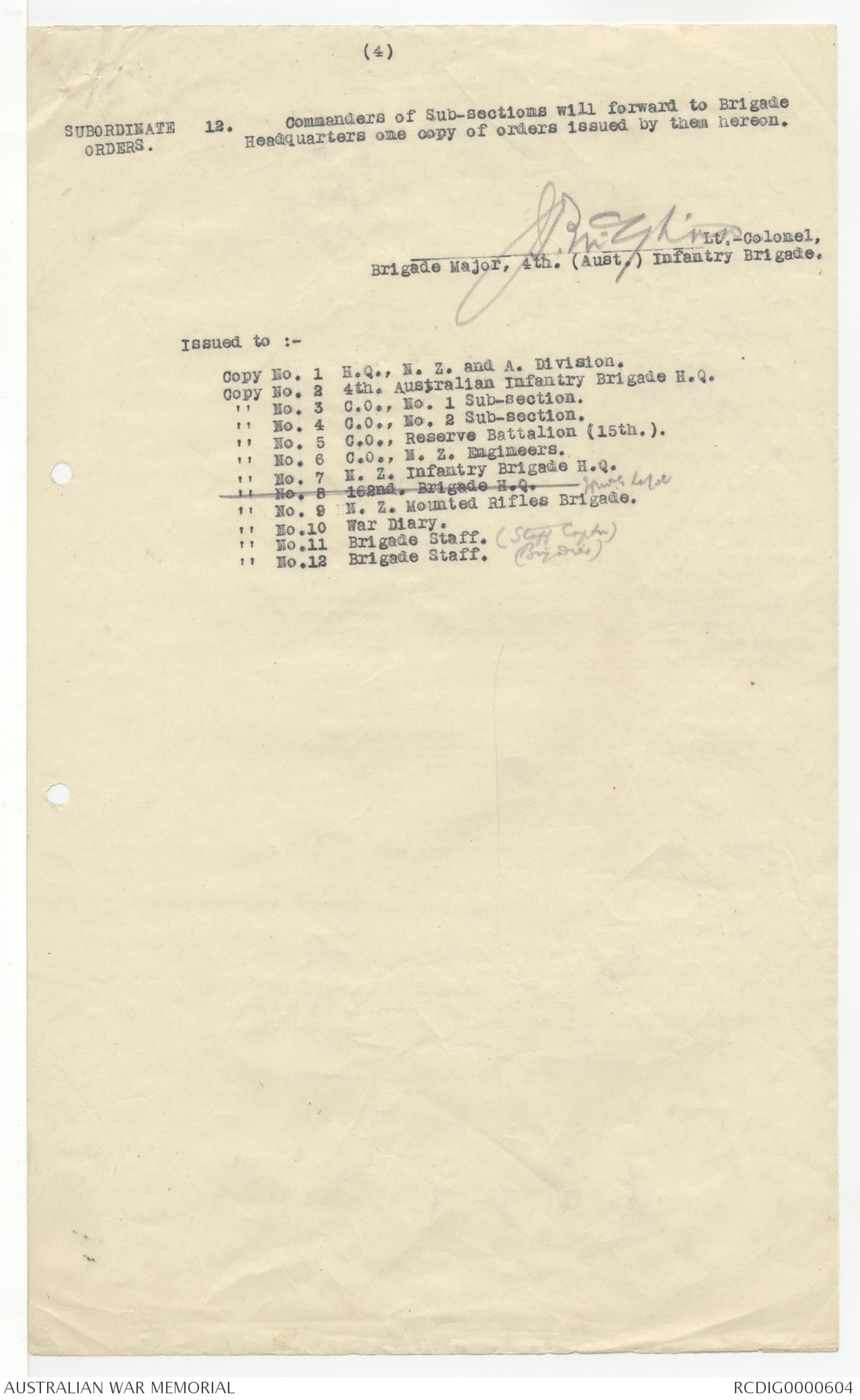
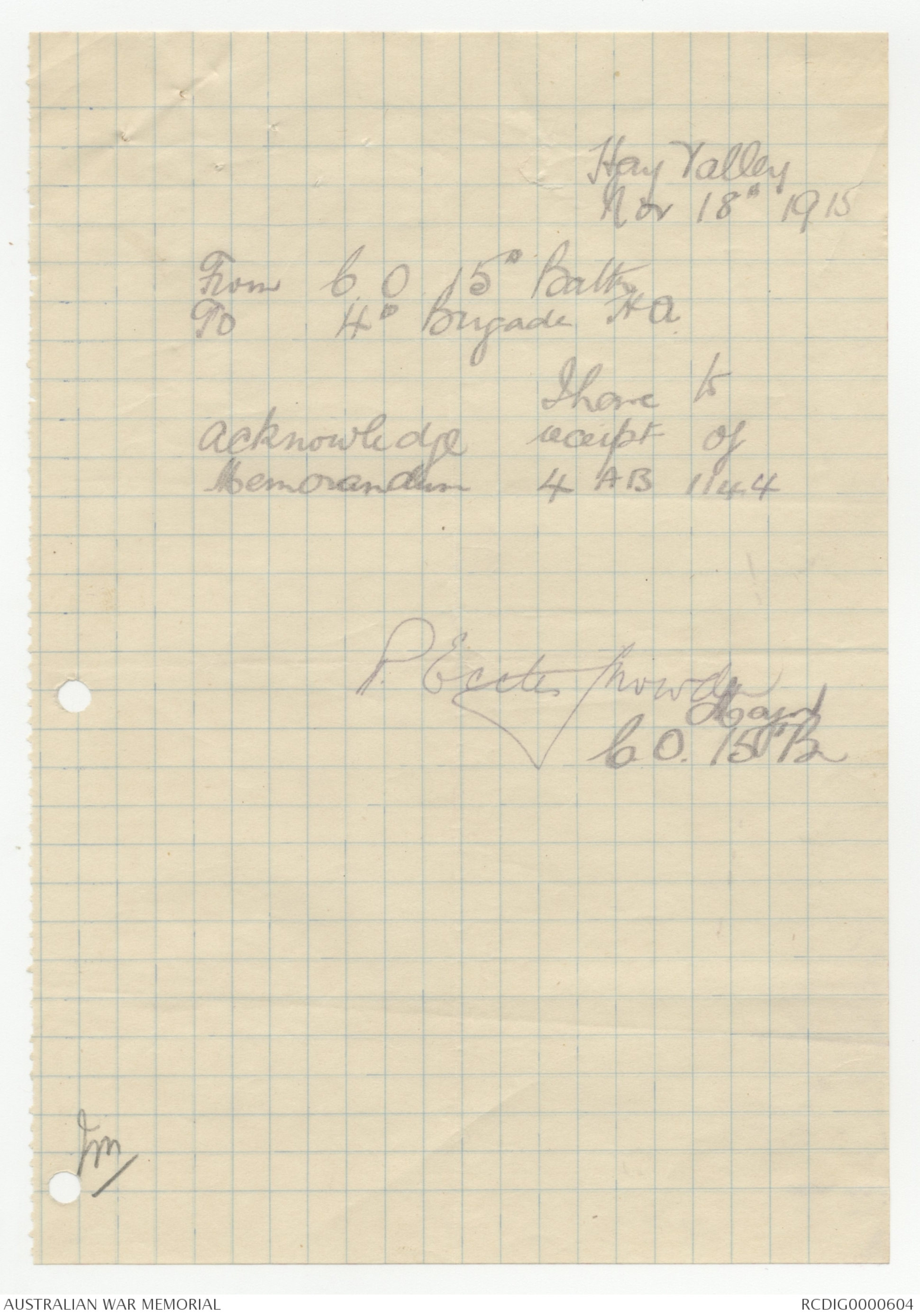
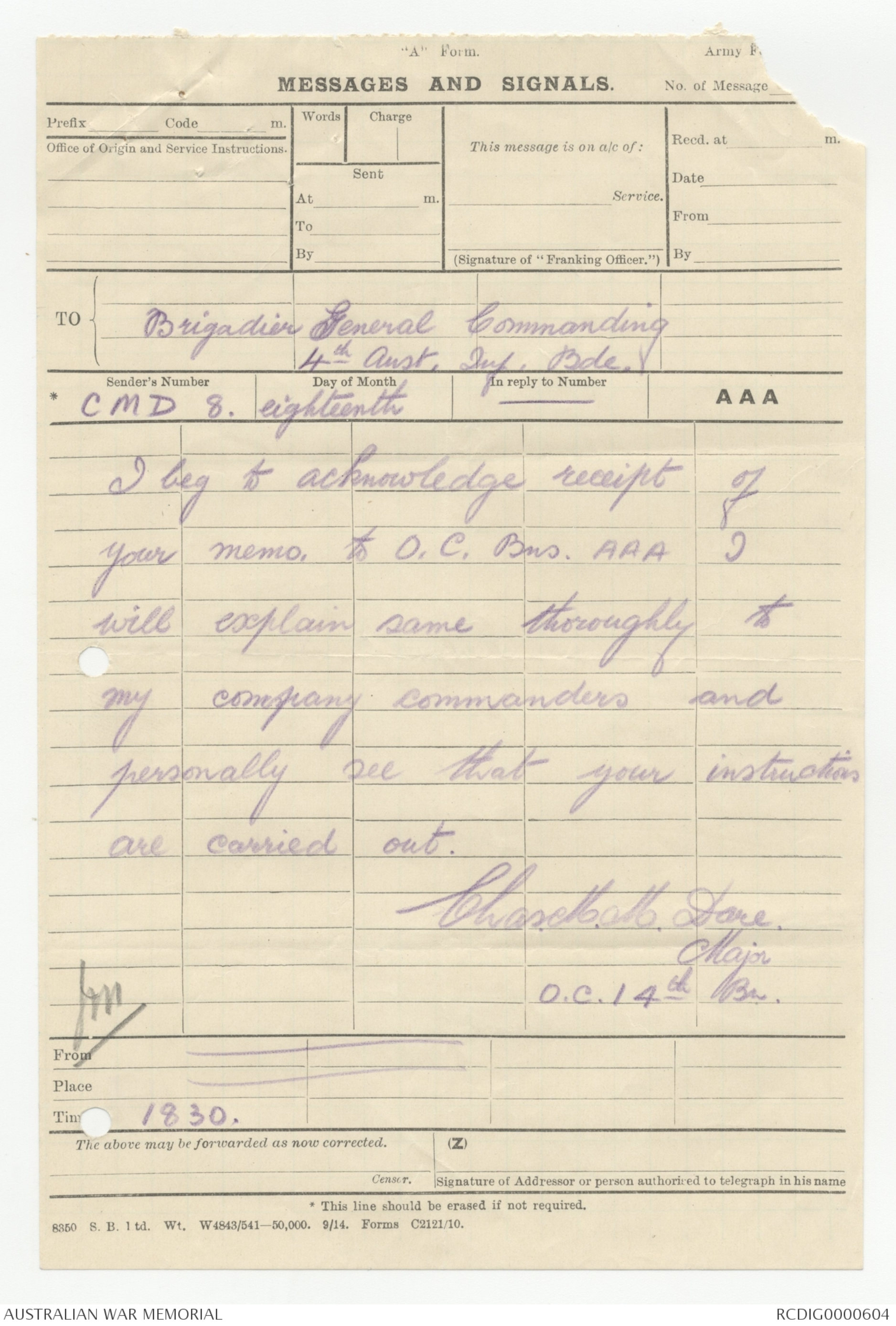
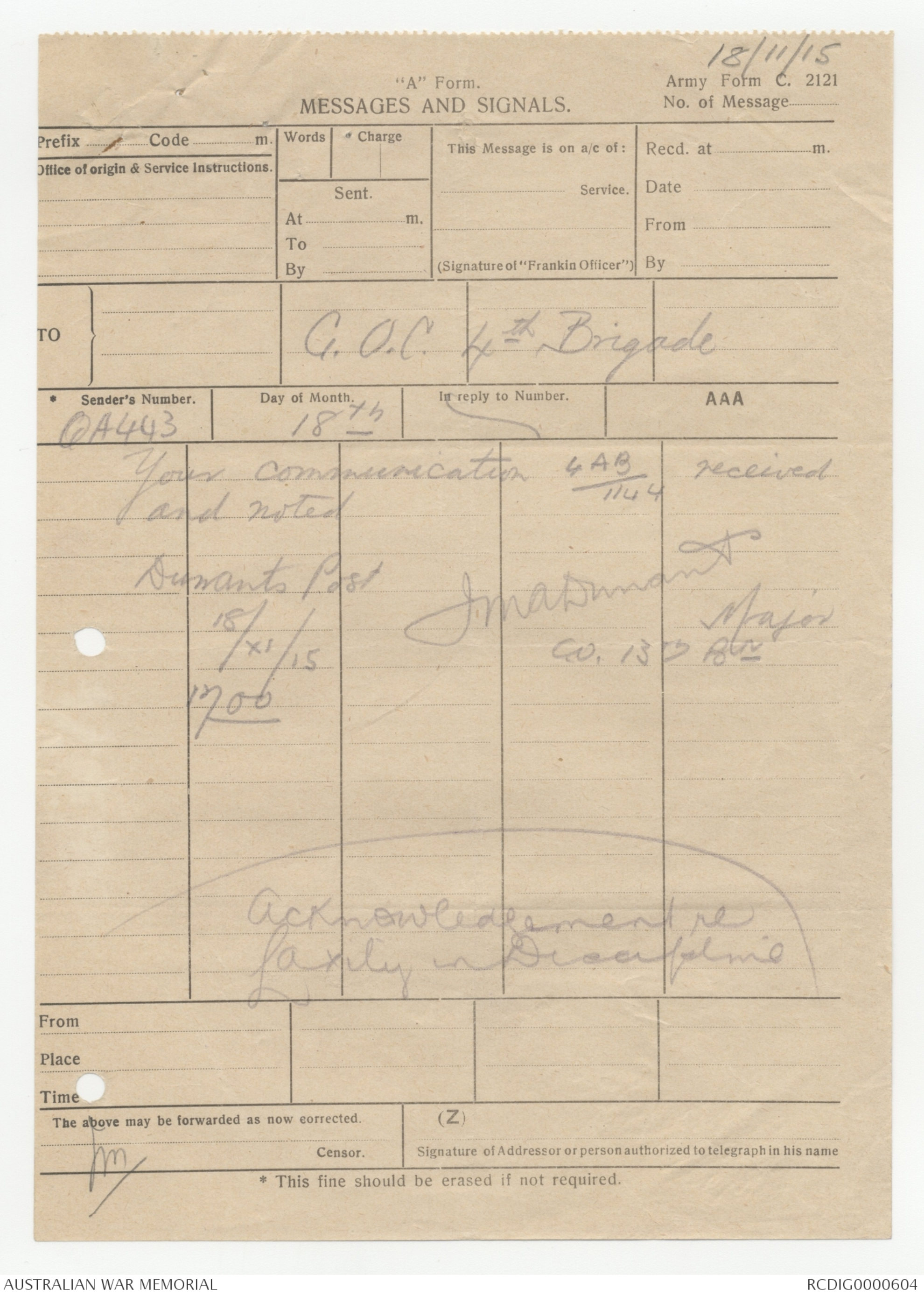
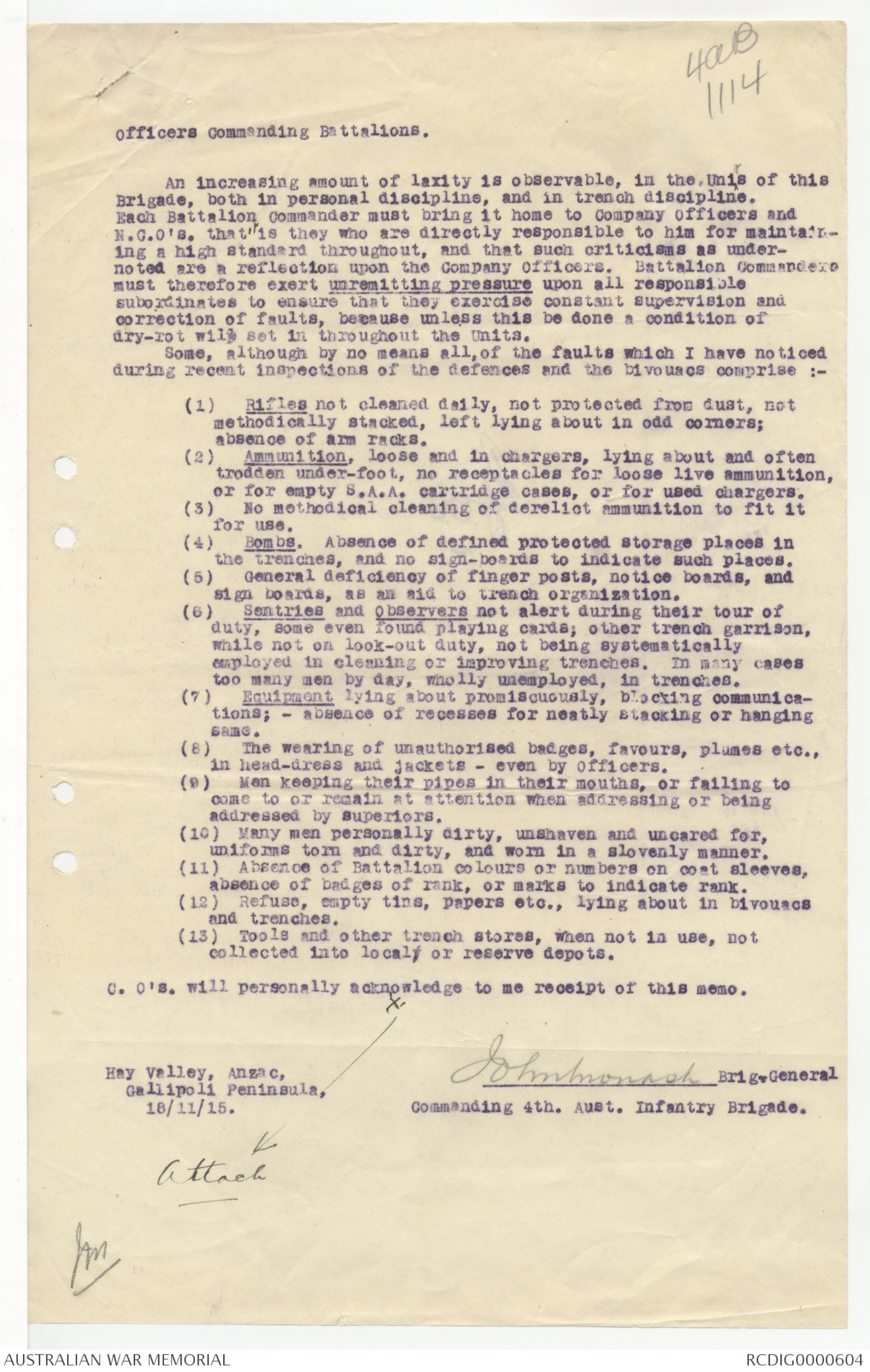
Hay Valley, Anzac,
Gallipoli Peninsula,
18th. November, 1915.
My Dear General,
B. P. asks for "criticisms". As I am not
sufficiently familiar with industrial, educational, and economic
conditions in the United Kingdon, my following remarks must be
taken to be influenced by Australian conditions only.
There is no room for any criticism as to the
desirability of an extended scheme of boy and youth training, as
outlined in the papers; diverse opinions can arise only as to its
practicability under given conditions.
Now, the introduction of Universal Military
Training in Australia, both Junior and Senior Cadet Training,
exercised avery powerful, and I am sorry to say, very adverse
influence upon the development of the Boy Scout movement. It has
been impossible to eradiate from the minds of the public and
especially of public men, the belief that the Boy Scout movement
was of a military character; only a comparatively few enthusiasts
have grasped the idea, that what is primarily aimed at is the development
of character in the boy. As a result of this erroneous state of
feeling, parents as & body have not actively encouraged their boys
to add Scout Training to their Cadet Training, because they
believed the latter to be all sufficient; and public men have
declined to recognise Scout training, or at any rate to embrace it
heartily, because they imagined it to be a competitor of cadet
training. This state of things is most regrettable, because it is
notorious that neither the Cadet training nor the training in
Technical Schools does anything worth considering in the direction
of developing or building up the boy's character, mentally or
morally, in the thorough and systematic manner aimed at by the
methods employed by the Boy Scout movement. It may be said that
the remedy for such a state of things is to better educate the
public upon the question, but several years of hard work on the
part of the aforesaid enthusiasts, powerfully aided by B.P's. own
crusade in Australia, has had no results commensurate with the
efforts put forth - measuring results by an extension of the Boy
Scout movement in point of numbers.
There is not and never was any question of the
great value to the boys themselves and to the nation of the
training they receive as Boy Scouts; and I do not think there
can be any question of the value of an increased application of
such training, by way either of an extension of the age or of the
tecnnical subjects of training, or both.
(But)
(2)
But the real criticism - it is hardly a criticism, but rather
an indication of difficulties - is that as the boy grows up, what
with his primary, and (latterly in Australia) free secondary
education, his technical training either in his trade, or in
technical schools, generally at night, and on top of all his
Compulsory Military Cadet Training, which absorbs most of his
daylight leisure (especially if he belong to that keen and ambitious
type of boy who wants to be a Boy Scout), he will have, as a rule,
absolutely no time left for participation in an extension of the
Scout movement.
In any attempt in Australia to introduce, on a comprehensive
scale, such extended Scout training as is outlined in B. P's.
appendices, we would have active opposition from two different
quarters - the very quarters from which active help, or to say the
least, passive tolerance ought to come; on the one hand the State
Education Departments who are in process of organizing Technical
Education in all its branches, as a State activity, and on the
other hand the Defence Department who have, in the past, at any rate,
often refused facilities for boys to be excused from drills and to
attend their Scout training.
1 think it very unlikely that, in Australis, the Authorities
would, as suggested in B. P's. scheme, accept the present or any
extended Scout training as a remission of any part of the Cadet
training. They have in the past refused to do this.
Undoubtedly the kernel of the scheme is the sympathetic
co-operation of the War Office, and in England where there is as
yet no Compulsory Cadet Training, such co-operation should ensure
the practicability of the scheme outlined in the papers.
Yours Sincerely,
J.M.
Major-General Sir A.J. Godley, K.C.M.G., C.B.,
Commanding N. 2. and A. Division.
SECRET.
Copy No 12
FOURTH INFANTRY BRIGADE Novr. 18TH., 1915
AUSTRALIAN
IMPERIAL FORCE
4aB
NOV 28 1915
2445
4th Infantry Brigade.
PLAN FOR DEFENCE OF SECTION
INTRODUCTORY.
-
The following plan of action is promulgated to meet the
contingency of a sudden attack. All preparatory measures
and arrangements will be completed forthwith.
In the event of a sudden attack, subordinate Commanders
will at once take action in accordance with this plan, without
waiting for further orders.
Both the extent and nature of the Defensive Works, and
the distribution of the personnel throughout the Section,
are subject to change in the future. The plan will therefore
require revision from time to time.
ORGANIZATION
AND
DISTRIBUTION
2. The Section of Defence allotted to the Fourth Australian
Infantry Brigade extends from the LEFT of the N.Z.. Infantry
Brigade on UPPER CHESHIRE RIDGE to WARWICK CASTLE and the
communication trench leading to FRANKLINS POST (inclusive)
and includes :-
Advanced Posts at SANDY KNOLL, FRANKLINS
POST, BECKS BLUFF, and NEWBERYS POST.
MAIN DEFENSIVE LINE on upper and lower
CHESHIRE RIDGE and on WARWICK CASTLE
ridge.
SECOND LINE - LITTLE TABLE TOP-ROSE HILL on
South side of Aghyl Dere only.
THIRD LINE on EASTERN spurs of Bauchope HILL
MACHINE GUN position on Rose Hill.
HOTCHKISS GUN position just N.W. of Rose
HILL i.e. at junction Hotchkiss Gully
with Aghyl Dere.
No. 1 Sub-Section extends from the RIGHT of the Section
to the Aghyl Dere (exclusive) and includes the Hotchkiss
gun position. It is garrisoned by the 13th and 14th Battalions
- is sub-divided as to frontage into 3 posts, numbered
from the RIGHT - and has allotted to it 10 machine guns, and
one Hotchkiss Gun.
No. 2 Sub-section extends from the Aghyl Dere (inclusive)
to the LEFT of the Section. It is garrisoned by the 16th.
Battalion, - its defences are grouped into 4 posts - and it
has allotted to it 4 machine guns. The line is prolonged to
the LEFT by the 54TH. DIVISION.
BRIGADE RESERVE is in Bivouac in Southern end of Hay
Valley, and also mans the two machine guns on Rose Hill
which are under the direct orders of the Brigade Machine Gun
Officer. The 15th. Battalion is Brigade Reserve. Brigade
Head Quarters, with Brigade Reserve of S.A.A., bombssiz,
and other trench stores, is located in Hay Valley.
Each sub-sectionshas its local Reserves of S.A.A., bombs,
and other Trench Stores.
A section of 2nd. Field Company, N. Z. Engineers, is
bivouaced in No. 1 Sub-section, and is available as part of
the local reserve to that Sub-section.
A battalion N. Z. Infantry Brigade is bivouaced within
the Brigade Area, at the right rear of No. 1 Sub-section,
but is not available for the defence of this Section.
The second line of Trenches, behind No. 2 Sub-section, is
garrisoned by a unit of 54th. Division, under independent
orders.
The FOURTH FIELD AMBULANGE is at WALDEN POINT. Anaarnam
advanced dressing station is established in Hotchkiss Valley
WEST of Little Table Top.
ARTILLERYCO-OPERATION
3. An Artillery Forward Observing Officer has a station near
the RIGHT of No. 1 Sub-section, and is connected by telephone
with the Artillery and with Brigade Headquarters, and through
the latter with both Sub-section Headquarters. From this
station the whole of the basin of the Aghyl Bere, EASTWARD
(of)
Para. 3 - Cont'd.
(2).
of our line, is under observation.
Six 18 pr. Field Guns and two 4½ inch Howitzers are
definitely allotted to the front of this Section - but the
N. Z. Infantry Brigade has priority of call upon them.
In addition, two 4 inch Naval Guns, four 4½ inch, twelve
5 inch, and two 6 inch Howitzers can be brought to bear on
our front, if not more urgently required for other targets
elsewhere.
MACHINE GUNS
4, FOR DEFENSIVE ACTION, the machine guns allotted to Sub-sections
remain under the direct orders of the C.O., Sub-section.
However, Machine Guns Nos. 1 & 3 are kept laid,
during darkness, upon the enemy trenches in front of APEX,
and engage enemy upon a pre-arranged signal from the APEX.
Machine Guns Nos. 15 and 16 on ROSE HILL are similarly
allotted during darkness for supporting the defence of the
APEX. In the event, however, of it becoming apparent that
the fire of these guns is required more urgently elsewhere,
it is competent for the Officers to whom the control of
these guns has been delegated, to employ them otherwise,
after reference to, and approval of, 4th. Infantry Brigade
Headquarters, which is in touch with N. Z. Infantry Brigade
Headquarters.
The tactical employment of the Hotchkiss gun is under
the command of No. 1 Sub-section.
PREPARATORY MEASURES include the determination of the
best emplacements and the selection of the guns best suited
to deliver fire upon the different parts of our Front, it
being remembered that oblique or enfilade Machine Gun fire
upon the advancing enemy is especially valuable,
TRENCHES
5. The Trench Garrison is divided into Firing Line, Supports,
and Local Reserves. While each post has its own local
reserves the Commander of each Sub-section retains under his
personal orders a Subsection Reserve, available for employment
in any part of the Sub-section.
Upon an attack being imminent or actually developing, the
front trenches will be manned, normally, by firing lines and
some supports only. The greatest care is to be exercised) y
to prevent the fire trenches from becoming overcrowded; and
the communication trenches from becoming blocked. Local
reserves are employed, normally, to replace casualties after
the supports have been used up and for local counter-attack
and to re-take any ground lost. For the latter purpose, all
Reserves must include a due proportion of grenadiers with
necessary bombs.
PREPARATORY MEASURES include the telling off of the
personnel to their several duties as above and their positions
of assembly upon an alarm, the determination of the positions
in the Fire Trenches from which fire can best be directed
upon the different portions of our Front, particularly as to
mutual support along the whole line, by enfilade fire; and
arrangements for allocating communication trenches, definitely,
to inward or outward traffic, so as to prevent congestion.
It has often been found difficult to prevent Supports and
Reserves from crowding into the forward defences or filling
up communication trenches without orders. This difficulty
must be met by clear orders on the subject.
ADVANCED POSTS
6. The advanced posts on FRANKLINS RIDGE and on BECKS BLUFF
are in no sense to be regarded as mere outpost positions, to
be evacuated in the face of a determined attack. Upon the
contrary, they are to be held at all costs as their possession
by the enemy would menace our main line. To this end
these advanced posts are being rapidly strengthened, and
provision made for considerably increasing their garrisons.
Moreover, they are capable of a prolonged defence in view of
the converging fire that can be brought to bear from many
points upon all ground which threatens these posts.
(7)
(3)
BRIGADE RESERVE.
7. Upon receipt of message or signal "ENEMY ATTACKING"
the C.O., Reserve Battalion, will send an officer to
Brigade Headquarters for orders, and will assemble the
Battalion fully armed in a formation which will enable
either the Battalion to move as a whole, or one or
more Companies to be detached for employment either in
the NIGHT RIGHT or the LEFT of the Section. The route
for detachments detailed for action in the RIGHT flank
of the Section is via the SAP AT THE EXTREME SOUTH END
OF HAY VALLEY; the route for those detailed for the
LEFT Flank of the Section is VIA THE SAP WHICH TERMINATES
NEAR BRIGADE HEADQUARTERS, AND THENCE PAST THE
HOTCHKISS GUN.
The Reserve Battalion must be held in readiness to
act rapidly either in reinforcing a portion of the
Front Line, or in manning the Second or Third Lines, or
in delivering a counter attack.
THE PREPARATORY MEASURES include the reconnaissance
by subordinate Commanders, within the Battalion, of all
routes and rear lines referred to in this para. They
must also be generally familiar with the main defences.
PERSONNEL.
8. During an attack, all personnel including cooks,
batmen, clerks, etc., are to be fully armed and
available.
PATROLS.
9. As the enemy's best chance of penetrating our lines
is by feeding large forces into the basin of the Aghyl
Dere under cover of darkness, and then attacking
unexpectedly, our best safe-guard is to be fully
warned of such a move. To this end, the systematic
patrolling of the main valley of the AGHYL DERE and its
tributaries, well up to the slopes of SARI BAIR RANGE
not only every night, but frequently during the night,
and under all conditions of weather is of the utmost
importancee, and must be continued as at present.
INFORMATION.
10. The principal factor in the successful control
of a defensive operation of this nature over an extended
front is the frequent, rapid and accurate transmission
by all subordinates to those in authority and
to Commanders on their flanks of information as to the
situation.
Negative information is just as valuable as
positive information.
All Commanders must therefore perfect and frequently
test the means (telephones, orderlies, signallers, etc)
with which they are provided for transmitting such
Information.
PROCEDURE.
11. These instructions are SECRET. Only the one
issued copy is to be kept in each Sub-section, and its
purport will, be communicated to officers only. As the
personnel changes, from day to day, through evacuations
and reinforcements, special steps must be taken to
ensure that all Officers newly joined, or rejoining,
are at once made fully cognizant hereof.
(12)
(4)
SUBORDINATE
ORDERS
12. Commanders of Sub-sections will forward to Brigade
Headquarters one copy of orders issued by them hereon.
JRMcGlinn Lt-Colonel,
Brigade Major, 4th (Aust.) Infantry Bridage.
Issued to :-
Copy No. 1 H.Q.. N. Z. and A. Division.
Copy No. 2 4th. Australian Infantry Brigade H.Q.
" No. 3 C.O., No. 1 Sub-section.
" No. 4 C.0., No. 2 Sub-section.
" No. 5 C.O., Reserve Battalion (15th.).
" No. 6 C.0.. N. Z. Engineers.
" No. 7 N.Z. Infantry Brigade H.Q.
" No. 8 162nd. Brugade H.Q. [*JPMcG Lt.Col *]
" No 9 N. Z. Mounted Rifles Brigade.
" No. 10 War Diary.
" No. 11 Brigade Staff. [*Staff Captn*]
" No. 12 Brigade Staff. [* Bdg Divs*]
Hay Valley
Nov 18th 1915
From CO 15th Batln
To 4th Brigade HQ
I have to
acknowledge receipt of
Memorandum 4AB 1144
R Eccles Snowden
Major
C.O. 15th Bn
JM
"A" Form. Army F
MESSAGES AND SIGNALS. No. of Message
Prefix Code Words
Office of Origin and Service Instructions.
Words. Charge
Sent
At m.
To
By
This message is on a/c of:
Service.
(Signature of "Franking Officer.")
Recd. at m.
Date
From
By
TO Brigadier General Commanding
4th Aust. Inf. Bde.
* Senders Number. Day of Month. In reply to Number AAA
CMD 8. Eighteenth
I beg to acknowledge receipt of
your memo. to O.C. Bns. AAA I
will explain same thoroughly to
my company commanders and
personally see that your instructions
are carried out.
Chas.M.M.Dare
Major
O.C. 14th Bn.
JM
From
Place
Time 1830
18/11/15
"A" Form. Army Form C.2121
MESSAGES AND SIGNALS. No. of Message
Prefix Code Words
Office of Origin and Service Instructions.
Words. Charge
Sent
At m.
To
By
This message is on a/c of:
Service.
(Signature of "Franking Officer.")
Recd. at m.
Date
From
By
TO G.O.C. 4th Brigade
* Senders Number. Day of Month. In reply to Number AAA
QA443 18th
Your communication 4AB/1144 received
and noted
Durrants Post
18/X1/15
1700
JMADurrant
Major
C.O. 13th Bn
[*Acknowledgement re
laxity in Discipline*]
From
Place
Time
JM
4AB
1144
Officers Commanding Battalions.
An increasing amount of laxity is observable, in the, units of this
Brigade, both in personal discipline, and in trench discipline.
Each Battalion Commander must bring it home to Company Officers and
N.C.0's. that it is they who are directly responsible to him for maintaining
a high standard throughout, and that such criticisms as undernoted
are a reflection upon the Company officers. Battalion Commanders
must therefore exert unremitting pressure upon all responsible
subordinates to ensure that they exercise constant supervision and
correction of faults, bevause unless this be done a condition of
dry-rot will set in throughout the Units.
Some, although by no means all, of the faults which I have noticed
during recent inspections of the defences and the bivouacs comprise: -
(1) Rifles not cleaned daily, not protected from dust, not
methodically stacked, left lying about in odd corners;
absence of arm racks.
(2) Ammunition, loose and in chargers, lying about and often
trodden under-foot, no receptacles for loose live ammunition,
or for empty S.A.A. cartridge cases, or for used chargers.
(3) No methodical cleaning of derelict ammunition to fit it
for use.
(4) Bombs. Absence of defined protected storage places in
the trenches, and no sign-boards to indicate such places.
(5) General deficiency of finger posts, notice boards, and
sign boards, as an aid to trench organization.
(6) Sentries and Observers not alert during their tour of
duty, some even found playing cards; other trench garrison,
while not on look-out duty, not being systematically
employed in cleaning or improving trenches. In many cases
too many men by day, wholly unemployed, in trenches.
(7) Equipment lying about promiscuously, blocking communications;
- absence of recesses for neatly stacking or hanging
same.
(8) The wearing of unauthorised badges, favours, plumes etc.,
in head-dress and jackets - even by Officers.
(9) Men keeping their pipes in their mouths, or failing to
come to or remain at attention when addressing or being
addressed by superiors.
(10) Many men personally dirty, unshaven and uncared for,
uniforms torn and dirty, and worn in a slovenly manner.
(11) Absence of Battalion colours or numbers on coat sleeves,
absence of badges of rank, or marks to indicate rank.
(12) Refuse, empty tins, papers etc., lying about in bivouacs
and trenches.
(13) Tools and other trench stores, when not in use, not
collected into localy or reserve depots.
C. O's. will personally acknowledge[* X*} to me receipt of this memo.
John Monash Brig-General
Commanding 4th. Aust. Infantry Brigade.
Hay Valley, ANZAC,
Gallipoli Peninsula,
18/11/15
Attach
JM
 Jacqueline Kennedy
Jacqueline KennedyThis transcription item is now locked to you for editing. To release the lock either Save your changes or Cancel.
This lock will be automatically released after 60 minutes of inactivity.